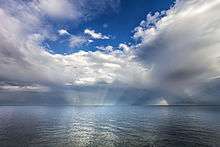Anticrepuscular rays




Anticrepuscular rays or antisolar rays[1] are similar to crepuscular rays, but seen opposite the sun in the sky. Anticrepuscular rays are near-parallel, but appear to converge at the antisolar point because of linear perspective.[2] Anticrepuscular rays are most frequently visible near sunrise or sunset. Crepuscular rays are usually much brighter than anticrepuscular rays. This is because for crepuscular rays, seen on the same side of the sky as the sun, the atmospheric light scattering and making them visible is taking place at small angles (see Mie theory).
Although anticrepuscular rays appear to converge onto a point opposite the sun, the convergence is actually an illusion. The rays are in fact (almost) parallel, and their apparent convergence is to the vanishing point at infinity.[3]
References
- ↑ Cowley, Les, "Anti-solar (anti-crepuscular) rays", Atmospheric Optics, retrieved March 19, 2015
- ↑ John A. Day (2005), The Book of Clouds, Sterling Publishing Company, Inc., pp. 124–127, ISBN 978-1-4027-2813-6, retrieved 2010-10-09
- ↑ Cowley, Les, "Antisolar rays", Atmospheric Optics, retrieved March 19, 2015
External links
 Media related to Anticrepuscular rays at Wikimedia Commons
Media related to Anticrepuscular rays at Wikimedia Commons- Atmospheric optics: anticrepuscular rays
- Images of anticrepuscular rays at Astronomy Picture of the Day site (copyrighted images):